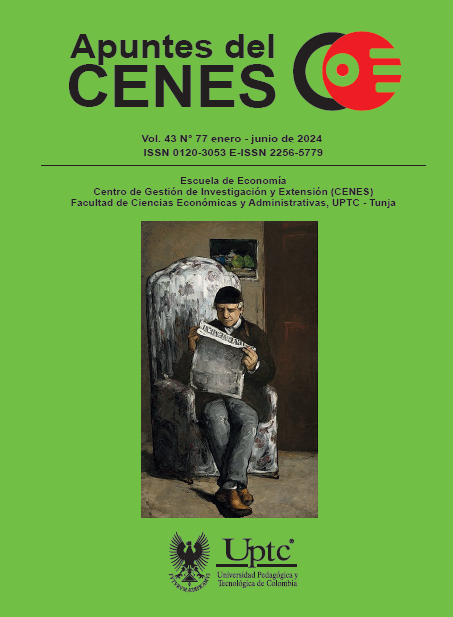Agricultural Production Conditions in Boyacá

Abstract
This article uses data from the Census of Agriculture 2014 pertaining to the Department of Boyacá. It connects the production performance at the municipal level to a set of rural determinants, which encompass the exploitation of the agricultural potential. This approach highlights features of the agricultural sector in Boyacá: the predominance of annual crops, the break-up of agricultural units, family arrangements to supply labor input, and the lack of a widespread export stuff, inter alia. The methodology employs a spatial approach that seeks to identify spatial patterns in the agricultural output, using the municipality as the spatial unit. We resort to spatial econometrics to model the determinants of the agricultural output, and to point out a better spatial structure according to the pool of data. The econometric results confirm a kind of spatial dependence in the error, suggesting the influence of common shocks affecting the agricultural output, everywhere the municipalities of Boyacá. Throughout the region, the traditional production profile, based on annual crops to satisfy the national consumption, prevails. This type of production depends on typical rural conditions: small plots of land, little mechanized production, family work and precarious wages.
Keywords
Census of Agriculture, agricultural production,, spatial econometrics, spatial interaction, productive structure, Boyacá, Colombia
References
- Anselin, L. (2001). Spatial Econometrics. In B. Baltagi (ed.), Companion to Theoretical Econometrics (pp. 310-330). Blackwell Publishing.
- Arbia, G. (2001). Modelling the Geography of Economic Activities on a Continuous Space. Papers in Regional Science, 80, 411-424. http://dx.doi.org/10.1007/PL00013646
- Arbia, G, Espa, G & Quah, D. (2008). A Class of Spatial Econometrics. Empirical Economics, 34(1), 81-103.
- Barrett, C., Bellemare, M. & Hou, J. (2010) Reconsidering Conventional Explanations of the Inverse Productivity–Size Relationship. World Development, 38(1), 88-97. http://dx.doi.org/10.1016/j.worlddev.2009.06.002
- Baysoy, M. (2023). Regional Growth Model with Spatial Externalities. In H. Arias & G. Antosova (eds.), Considerations of Territorial Planning, Space, and Economic Activity in the Global Economy. IGI Global. http://dx.doi.org/10.4018/978-1-6684-5976-8
- Bernat, A. (1996). Does Manufacturing Matter? A Spatial Econometric View of Kaldor’s view. Journal of Regional Science, 36(3), 463-477.
- Berry, A. (2017), La agricultura familiar y la inclusión: un factor contribuyente a la paz. Revista Colombiana de Ciencias Pecuarias, 30, 9-12
- Chasco, C. (2003). Métodos gráficos del análisis exploratorio de datos espaciales. En Anales de economía aplicada. Asociación Española de Economía Aplicada.
- CGIAR. (2021). Análisis de oportunidades de mercado para productos agropecuarios de Boyacá, con potencialidad para reducir la emisión de carbono mediante una producción adaptada al clima. Documento de trabajo. Programa de Investigación de CGIAR en Cambio Climático, Agricultura y Seguridad Alimentaria
- DANE. (2014). Censo Nacional Agropecuario. Novena entrega de resultados 2014. DANE.
- Dubin, R. (1998). Spatial Autocorrelation: A Primer. Journal of Housing Economics, 7, 304-327. https://doi.org/10.1006/jhec.1998.0236
- Duranton, G. & Overman, H. (2005). Testing for Localization Using Micro-geographic Data. Review of Economic Studies, 72(4), 1077-1106. https://doi.org/10.1111/0034-6527.00362
- Elhorst, P. (2010). Applied Spatial Econometrics: Raising the Bar. Spatial Economic Analysis, 5(1). http://dx.doi.org/10.1080/17421770903541772
- Fedesarrollo. (2019). Uso potencial y efectivo de la tierra agrícola en Colombia: resultados del Censo Nacional Agropecuario. Fedesarrollo.
- Helsen, J. (2008). Essays on the Spatial Analysis of Manufacturing. In Ph. D. Dissertation, Ken State University. Graduate School of Management.
- Krugman P. (1992). Geografía y comercio. Antoni Bosch.
- Machado, A. (2015) El Censo Agropecuario: sorpresas o confirmaciones. Razón Pública. https://razonpublica.com/el-censo-agropecuario-sorpresas-o-confirmaciones/
- Moreno, R. & Vayá, E. (2002). Econometría espacial: nuevas técnicas para el análisis regional. Una aplicación a las regiones europeas. Investigaciones Regionales, (1), 83-106.
- Osland, L. (2010). An Application of Spatial Econometrics in Relation to Hedonic House Price Modeling. Journal of Real Estate Research, 32(3), 289-320. http://dx.doi.org/10.1080/10835547.2010.12091282
- Rojas, N. (2019). Determinantes de la productividad agrícola. Archivos de Macroeconomía, (500).
- Suescún, C. (2013) La inercia de la estructura agraria en Colombia: determinantes de la concentración especial de la tierra mediante un enfoque especial. Cuadernos de Economía, 32(61) 653-682.
- UNDP. (2011). Colombia rural. Razones para la esperanza. Informe Nacional de DesarrolloUrbano. https://www.undp.org/sites/g/files/zskgke326/files/migration/co/undp-co-ic_indh2011-parte1-2011.pdf
